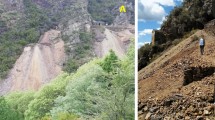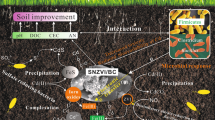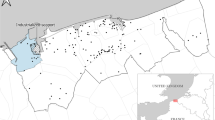Abstract
Recently, some new leaching agents without ammonium, such as magnesium sulfate (MgSO4) and aluminum sulfate [Al2(SO4)3], have been developed to eliminate ammonia nitrogen pollution in in situ mining process of the weathered crust elution-deposited rare earth ore (WCED-REO), but they might cause heavy metal contamination. In this study, characteristics and mechanisms of different fractions of lead (Pb) released by (NH4)2SO4, MgSO4 and Al2(SO4)3 leaching agents were investigated using batch experiments and column leaching tests. The experimental results showed that the amounts of Pb released by the different leaching agents followed the trend of Al2(SO4)3 > (NH4)2SO4 > MgSO4 under the same total cationic charge, and both the acid extractable and reducible fractions of Pb were released. The release of acid extractable fraction Pb was related to the cation hydration radius of NH4+, Mg2+, and Al3+, whereas the release of reducible fraction Pb was mainly influenced by the concentration of H+, especially at pH < 4.0. Furthermore, column leaching tests indicated that pH has little effect on the Pb contents of different fractions released by (NH4)2SO4 and MgSO4 in leaching the WCED-REO. Although Al2(SO4)3 released the largest contents of rare earth and Pb in leachate, the content of residual acid extractable fraction Pb in soil was the most after water injection (simulating the cleaning process after mining). This work can provide a scientific method and theoretical basis for comprehensively assessing the environmental impact of new leaching agents on WCED-REO mining.
Graphical abstract







Similar content being viewed by others
Data availability
The datasets used and/or analyzed during the current study are available from the corresponding author on reasonable request.
References
Arunachalam J, Emons H, Krasnodebska B, Mohl C (1996) Sequential extraction studies on homogenized forest soil samples. Sci Total Environ 181:147–159. https://doi.org/10.1016/0048-9697(95)05005-1
Bao Z, Zhao Z (2008) Geochemistry of mineralization with exchangeable REY in the weathering crusts of granitic rocks in South China. Ore Geol Rev 33:519–535. https://doi.org/10.1016/j.oregeorev.2007.03.005
Chen Z (2011) Global rare earth resources and scenarios of future rare earth industry. J Rare Earths 29:1–6. https://doi.org/10.1016/s1002-0721(10)60401-2
Chen L, Jin X, Chen H, He Z, Qiu L, Duan H (2020) Grain size distribution and clay mineral distinction of rare earth ore through different methods. Minerals. 10:353. https://doi.org/10.3390/min10040353
Chi R, Tian J (2006) Hydrometallurgy of the weathered crust elution-deposited rare earth ores. Science Press, Beijing
Chi R, Tian J (2008) Weathered crust elution-deposited rare earth ores. Nova Science Publishers
Chi R, Tian J, Li ZJ, Peng C, Wu YX, Li SR, Wang CW, Zhou ZA (2005) Existing state and partitioning of rare earth on weathered ores. J Rare Earths 23:756–759
Fan X, Xue Q, Liu SW, Tang J, Qiao JY, Huang YY, Sun JM, Liu NN (2021) The influence of soil particle size distribution and clay minerals on ammonium nitrogen in weathered crust elution-deposited rare earth tailing. Ecotoxicol Environ Saf 208:111663. https://doi.org/10.1016/j.ecoenv.2020.111663
Goulding KW (2016) Soil acidification and the importance of liming agricultural soils with particular reference to the United Kingdom. Soil Use Manag 32:390–399. https://doi.org/10.1111/sum.12270
He Z, Zhang R, Nie W, Zhang Z, Chi R, Xu Z, Wu M, Qu J (2019) Leaching process and mechanism of weathered crust elution-deposited rare earth ore. Min Metall Explor 36:1021–1031. https://doi.org/10.1007/s42461-019-00116-5
Huang XW, Long ZQ, Wang LS, Feng ZY (2015) Technology development for rare earth cleaner hydrometallurgy in China. Rare Metals 34:215–222. https://doi.org/10.1007/s12598-015-0473-x
Humphries M (2013) Rare earth elements: the global supply chain. Congressional Research Service, Washington, DC
Inyang HI, Onwawoma A, Bae S (2016) The Elovich equation as a predictor of lead and cadmium sorption rates on contaminant barrier minerals. Soil Tillage Res 155:124–132. https://doi.org/10.1016/j.still.2015.07.013
Li L, Holm PE, Marcussen H, Hansen HCB (2014) Release of cadmium, copper and lead from urban soils of Copenhagen. Environ Pollut 187:90–97. https://doi.org/10.1016/j.envpol.2013.12.016
Liu JH, Chen LK, Liu CY, Qiu LR, He S (2018) Pb speciation in rare earth minerals and use of entropy and fuzzy clustering methods to assess the migration capacity of Pb during mining activities. Ecotoxicol Environ Saf 165:334–342. https://doi.org/10.1016/j.ecoenv.2018.09.007
Liu WS, Guo MN, Liu C, Yuan M, Chen XT, Huot H, Zhao CM, Tang YT, Morel JL, Qiu RL (2019) Water, sediment and agricultural soil contamination from an ion-adsorption rare earth mining area. Chemosphere. 216:75–83. https://doi.org/10.1016/j.chemosphere.2018.10.109
Long P, Wang GS, Tian J, Hu SL, Luo SH (2019) Simulation of one-dimensional column leaching of weathered crust elution-deposited rare earth ore. Trans Nonferrous Metals Soc China 29:625–633. https://doi.org/10.1016/s1003-6326(19)64972-1
Ma Y, Liu C (1999) Trace element geochemistry during chemical weathering. Chin Sci Bull 44:2260–2263. https://doi.org/10.1007/BF02885934
Moldoveanu GA, Papangelakis VG (2012) Recovery of rare earth elements adsorbed on clay minerals: I. Desorption mechanism. Hydrometallurgy. 117-118:71–78. https://doi.org/10.1016/j.hydromet.2012.02.007
Moldoveanu GA, Papangelakis VG (2013) Recovery of rare earth elements adsorbed on clay minerals: II. Leaching with ammonium sulfate. Hydrometallurgy. 131-132:158–166. https://doi.org/10.1016/j.hydromet.2012.10.011
Nightingale ER (1959) Phenomenological theory of ion solvation. Effective radii of hydrated ions. J Phys Chem A 63:1381–1387. https://doi.org/10.1021/j150579a011
Pan Y, Li H (2016) Investigating heavy metal pollution in mining brownfield and its policy implications: a case study of the Bayan Obo rare earth mine, Inner Mongolia, China. Environ Manag 57:879–893. https://doi.org/10.1007/s00267-016-0658-6
Qiao J, Tang J, Xue Q (2020) Study on Pb release by several new lixiviants in weathered crust elution-deposited rare earth ore leaching process: behavior and mechanism. Ecotoxicol Environ Saf 190:110–138. https://doi.org/10.1016/j.ecoenv.2019.110138
Qiu T, Fang X, Cui L, Fang Y (2008) Behavior of leaching and precipitation of weathering crust ion-absorbed type by magnetic field. J Rare Earths 26:274–278. https://doi.org/10.1016/s1002-0721(08)60080-0
Si W, He X, Li A, Liu L, Li J, Gong D, Liu J, Liu J, Shen W, Zhang X (2016) Application of an integrated biomarker response index to assess ground water contamination in the vicinity of a rare earth mine tailings site. Environ Sci Pollut Res Int 23:17345–17356. https://doi.org/10.1007/s11356-016-6728-8
Tang J, Xue Q, Chen H, Li W (2017) Mechanistic study of lead desorption during the leaching process of ion-absorbed rare earths: pH effect and the column experiment. Environ Sci Pollut Res Int 24:12918–12926. https://doi.org/10.1007/s11356-017-8814-y
Tang J, Qiao J, Xue Q, Liu F, Chen H, Zhang G (2018) Leach of the weathering crust elution-deposited rare earth ore for low environmental pollution with a combination of (NH4)2SO4 and EDTA. Chemosphere 199:160–167. https://doi.org/10.1016/j.chemosphere.2018.01.170
Tansel B, Sager JC, Rector T, Garland JL, Strayer RF, Levine LH, Roberts MS, Hummerick M, Bauer J (2006) Significance of hydrated radius and hydration shells on ionic permeability during nanofiltration in dead end and cross flow modes. Sep Purif Technol 51:40–47. https://doi.org/10.1016/j.seppur.2005.12.020
Tian J, Yin JQ, Chen KH, Rao GH, Jiang MT, Chi R (2010) Optimisation of mass transfer in column elution of rare earths from low grade weathered crust elution-deposited rare earth ore. Hydrometallurgy. 103:211–214. https://doi.org/10.1016/j.hydromet.2010.04.003
Tian J, Yin JQ, Chen KH, Rao GH, Jiang MT, Chi R (2011) Extraction of rare earths from the leach liquor of the weathered crust elution-deposited rare earth ore with non-precipitation. Int J Miner Process 98(3-4):125–131. https://doi.org/10.1016/j.minpro.2010.11.007
Tian J, Yin J, Tang X, Chen J, Luo X, Rao G (2013) Enhanced leaching process of a low-grade weathered crust elution-deposited rare earth ore with carboxymethyl sesbania gum. Hydrometallurgy. 139:124–131. https://doi.org/10.1016/j.hydromet.2013.08.001
Van Herreweghe S, Swennen R, Vandecasteele C, Cappuyns V (2003) Solid phase speciation of arsenic by sequential extraction in standard reference materials and industrially contaminated soil samples. Environ Pollut 122(3):323–342. https://doi.org/10.1016/S0269-7491(02)00332-9
Wang X, Lei Y, Ge J, Wu S (2015) Production forecast of China’s rare earths based on the Generalized Weng model and policy recommendations. Res Policy 43:11–18. https://doi.org/10.1016/j.resourpol.2014.11.002
Xiao YF, Feng ZY, Hu GH, Huang L, Huang XW, Chen YY, Li ML (2015a) Leaching and mass transfer characteristics of elements from ion-adsorption type rare earth ore. Rare Metals 34:357–365. https://doi.org/10.1007/s12598-015-0481-x
Xiao YF, Feng ZY, Huang XW, Huang L, Chen YY, Wang LS, Long ZQ (2015b) Recovery of rare earths from weathered crust elution-deposited rare earth ore without ammonia-nitrogen pollution: I. leaching with magnesium sulfate. Hydrometallurgy. 153:58–65. https://doi.org/10.1016/j.hydromet.2015.02.011
Xiao YF, Feng ZY, Huang XW, Huang L, Chen YY, Liu XS, Wang LS, Long ZQ (2016) Recovery of rare earth from the ion-adsorption type rare earths ore: II. Compound leaching. Hydrometallurgy 163:83–90. https://doi.org/10.1016/j.hydromet.2016.03.016
Xiao YF, Gao GH, Huang L, Feng ZY, Lai FG, Long ZQ (2018) A discussion on the leaching process of the ion-adsorption type rare earth ore with the electrical double layer model. Miner Eng 120:35–43. https://doi.org/10.1016/j.mineng.2018.02.015
Xu Q, Sun Y, Yang L, Li C, Zhou X, Chen W, Li Y (2019) Leaching mechanism of ion-adsorption rare earth by mono valence cation electrolytes and the corresponding environmental impact. J Clean Prod 211:566–573. https://doi.org/10.1016/j.jclepro.2018.11.112
Yang X, Zhang J (2015) Recovery of rare earth from ion-adsorption rare earth ores with a compound lixiviant. Sep Purif Technol 142:203–208. https://doi.org/10.1016/j.seppur.2014.11.050
Yang X, Gu Z, Fane A (1999) Extraction and group separation of rare earths by a combined extraction/electrostatic pseudo liquid membrane from simulated rare earths mine water. Materials Science Forum, Trans Tech Publ. 275–281. https://doi.org/10.4028/www.scientific.net/MSF.315-317.275.
Yang S, Xue Q, Chen H (2016) Enhanced recovery of water due to ammonia nitrogen contamination caused by mining processes. Environ Earth Sci 75:1102. https://doi.org/10.1007/s12665-016-5908-7
Yang L, Wang D, Li C, Sun Y, Zhou X, Li Y (2018) Searching for a high efficiency and environmental benign reagent to leach ion-adsorption rare earths based on the zeta potential of clay particles. Green Chem 20:4528–4536. https://doi.org/10.1039/C8GC01569D
Yang L, Li C, Wang D, Li F, Liu Y, Zhou X, Liu M, Wang X, Li Y (2019) Leaching ion adsorption rare earth by aluminum sulfate for increasing efficiency and lowering the environmental impact. J Rare Earths 37:429–436. https://doi.org/10.1016/j.jre.2018.08.012
Yin JQ, Zou ZQ, Tian J (2020) Preparation of crystalline rare earth carbonates with large particle size from the lixivium of weathered crust elution-deposited rare earth ores. Int J Miner Metall Mater 27(11):1482–1488. https://doi.org/10.1007/s12613-020-2066-4
Zhang QY, Ren F, Li FD, Chen GL, Yang G, Wang JQ, Du K, Liu SH, Li Z (2020) Ammonia nitrogen sources and pollution along soil profiles in an in-situ leaching rare earth ore. Environ Pollut 267:115449. https://doi.org/10.1016/j.envpol.2020.115449
Funding
This work was financially supported by the Fundamental Research Fund for the Central Universities (No. 2652019115), the Research Fund of China Geological Survey (DD20190703 and 20190323), Guangxi key research project (GuikeAB18050026), and the Natural Science Foundation of China (Grants 41731282 and 41672239).
Author information
Authors and Affiliations
Contributions
Jie Tang: Conceptualization, validation, visualization, writing of original draft, and writing of review and editing; Jiyang Qiao: Methodology, investigation, data curation. Qiang Xue: Conceptualization, supervision, funding acquisition, and writing of review and editing. Fei Liu: Supervision, funding acquisition, project administration, and writing of review and editing. Xin Fan: Methodology, investigation, and formal analysis. Siwen Liu: Investigation and formal analysis. Yuanying Huang: Investigation and formal analysis.
Corresponding authors
Ethics declarations
Ethics approval and consent to participate
Not applicable.
Consent for publication
Not applicable.
Conflict of interest
The authors declare that they have no conflict of interest.
Additional information
Responsible Editor: Philippe Garrigues
Publisher’s note
Springer Nature remains neutral with regard to jurisdictional claims in published maps and institutional affiliations.
Highlights
• Pb release by different lixiviants are in order of Al2(SO4)3 > (NH4)2SO4 > MgSO4.
• NH4+, Mg2+, and Al3+ affect release of acid extractable fraction Pb.
• The release of reducible fraction Pb primarily depends on H+.
• The effect of pH in (NH4)2SO4 and MgSO4 on Pb release is small during mining.
• Residual acid extractable fraction Pb was the greatest after Al2(SO4)3 leaching.
Rights and permissions
About this article
Cite this article
Tang, J., Qiao, J., Xue, Q. et al. Behavior and mechanism of different fraction lead leach with several typical sulfate lixiviants in the weathered crust elution-deposited rare earth ore. Environ Sci Pollut Res 28, 31885–31894 (2021). https://doi.org/10.1007/s11356-021-13039-w
Received:
Accepted:
Published:
Issue Date:
DOI: https://doi.org/10.1007/s11356-021-13039-w




